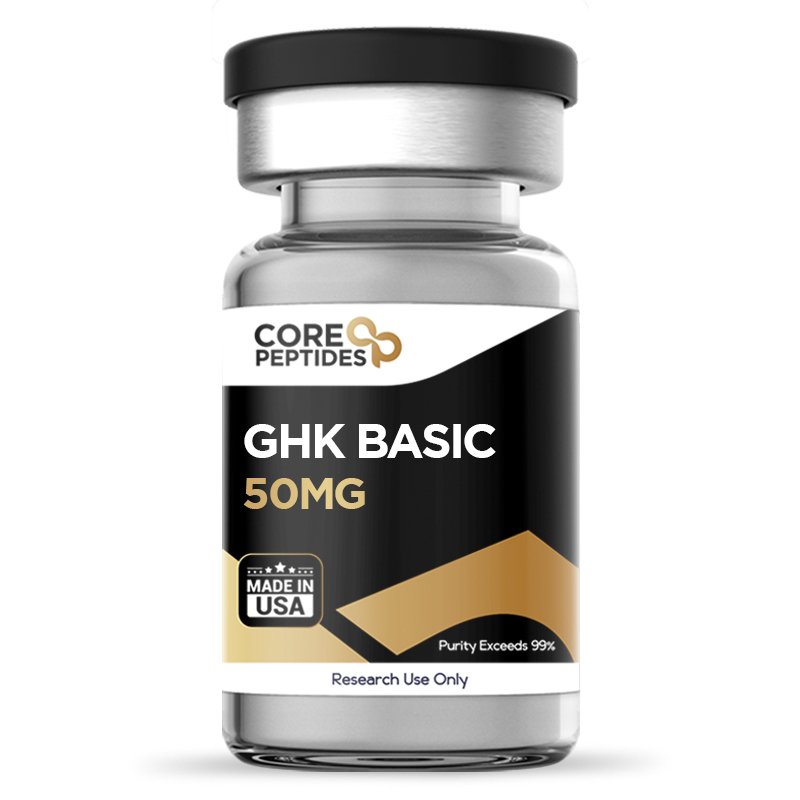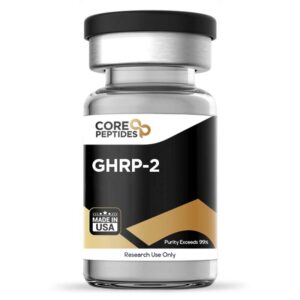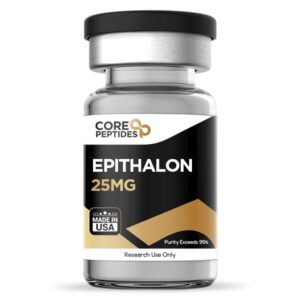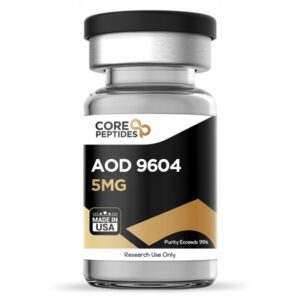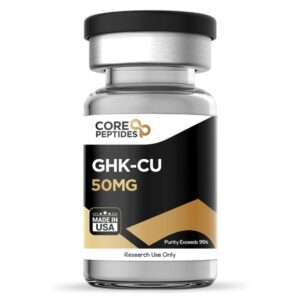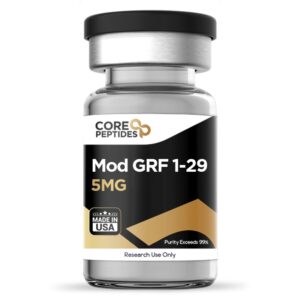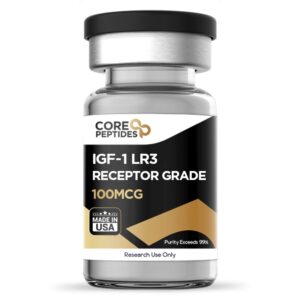GHK Basic (50mg)
$49.00
Size: 50mg
Contents: GHK Basic (50mg)
Form: Lyophilized powder
Purity: >99%
SKU: P-GHK-Basic
FREE Shipping on $200+ orders
Discount per Quantity
| Quantity | Discount | Price |
|---|---|---|
| 5 - 8 | 5% | $46.55 |
| 9 + | 10% | $44.10 |
GHK Basic Peptide
GHK Basic is a tripeptide containing the amino acid sequence glycyl-histidyl-lysine. This short-chain peptide is considered to help cell communication for a wide range of actions.
Research on the GHK has yielded a variety of potential biological activities, including possible stimulation of blood vessels and nerve outgrowth, increasing elastin, glycosaminoglycan, collagen synthesis, and possibly promoting dermal fibroblast functions. The tissue repair potential of this peptide has been researched in lung connective tissue, bone tissue, liver, stomach lining, and skin.(1)
The peptide has also been suggested to play some role in DNA repair, lung protection, fibroblast reactivation, and possibly in suppressing proinflammatory and pro-aging molecules like NFκB. GHK Basic has also been suggested to have the potential to repair protective proteins in the skin barrier.
Chemical Makeup(2)
Molecular Formula: C14H24N6O4
Molecular Weight: 340.4 g/mol
Research and Clinical Studies
GHK Basic and Skin Cell Regeneration
According to research, adding plasma to aged liver tissue may cause the aged tissues to produce proteins identical to those seen in plasma.(2,3,4) Several studies have suggested that GHK proteins may increase collagen production, glycosaminoglycans, and small proteoglycans such as decorin. Furthermore, research indicates that GHK might also influence the activities of metalloproteinases – enzymes that initiate extracellular matrix protein breakdown – and antiprotease actions. This GHK action may regulate skin protein breakdown, potentially preventing damaged protein accumulation and excessive proteolysis.
GHK Basic and Wound Healing
Animal model studies suggest the peptide may promote wound healing through two possible mechanisms. First, GHK, when combined with a high-concentration helium-neon laser, was reported to accelerate wound contraction and granular tissue production while hosting antioxidant enzyme activities and increasing blood vessel growth.(5) Second, wound healing in control and diabetic murine models was reported to be improved by collagen dressing loaded with GHK. The researchers commented that “the wounds were almost closed by 99.39% when [exposed to] biotinylated GHK-loaded films on day 21 when compared to 69.49% wound closure for plain films.” Increased glutathione and ascorbic acid levels were found, as well as enhanced epithelialization and increased collagen synthesis, fibroblasts, and mast cell activation in wounds.(6)
GHK and its analogs may also have potential in follicular stimulation and growth. Researchers reported the naturally occurring copper complex GHK-Cu to increase vascular endothelial growth factor production, possibly leading to growth and new blood vessel formation. In one murine experiment, the copper-containing version of GHK appeared to mediate a significant decrease in wound area compared to placebo. Wounds exposed to the copper-containing version of GHK were suggested to have lower concentrations of the pro-inflammatory markers MMP-2, MMP-9, and TNF-alpha.(7)
Notably, the copper-containing versions of GHK may also help reduce some potential complications that may negatively impact wound healing, such as colonization of the wound with pathogenic microorganisms. A study of GHK on diabetic ulcers stated that the peptide may have sped up wound closure in larger ulcers and reduced the risk of wound infections compared to the study group that received only a vehicle (placebo). More specifically, the researchers commented that “the enhancement of wound closure was more pronounced (median of 89.2% compared with −10.3% for vehicle; p < 0.01) in larger (greater than 100 mm2 initial area at study entry) plantar ulcers.” The incidence of ulcer infections was also significantly lower, equal to about 7% in the GHK group compared to 34% for vehicle.(8)
GHK Basic and Anti-inflammatory, Antioxidant Activities
GHK has been suggested to exhibit potential antioxidant action, specifically in its posited interaction with lipid peroxidation, a process which produces adverse free radicals capable of DNA, protein, and cell damage. GHK may help minimize this damage by binding the byproducts of this process.(9) The specific radicals suggested by the scientists include 4-hydroxynoneal, acrolein, malondialdehyde, and others.
Further, it has also been proposed that GHK might play a role in diminishing the release of iron from ferritin, an agent that catalyzes lipid peroxidation. More specifically, studies have suggested that GHK could potentially limit the creation of iron compounds in injured tissues, thereby mitigating inflammation.(10) It is believed that GHK's mechanism may involve attaching to ferritin's iron release pathways, potentially decreasing -Fe release by an estimated 87%, which might, in theory, curb inflammation and oxidation in affected tissues.
The anti-inflammatory potential of GHK might benefit specific tissues like the lungs. An experiment in murine models examined GHK's impact on lipopolysaccharide-induced lung inflammation.(11) The findings suggest that GHK may lower the generation of reactive oxygen species and inflammatory cytokines while boosting the efficacy of antioxidant enzymes. It is thought to hinder the activation of NF-κB and p38 MAPK signaling pathways, reducing TNF-1 and IL-6 levels. Moreover, the study noted that GHK seemed to mitigate lung tissue alterations and lessen inflammation in murine models suffering from lung damage. More specifically, the peptide was reported to have decreased the influx of inflammatory cells into the lung tissue in cases of experimentally induced acute lung injury in these models. GHK might also contribute to alleviating oxidative stress in lung tissues related to smoke exposure. Research indicates that GHK may suppress oxidative stress in alveolar epithelial cells through the upregulation of Nrf2 expression.(12)
GHK Basic and Fibrinogen
High fibrinogen levels are considered to increase blood viscosity by increasing rouleaux formation, which research suggests are risk factors for cardiovascular disease.(13) Studies on the peptide generally suggest that it has the potential to inhibit fibrinogen synthesis, thereby possibly lowering the risk of coronary occurrences.
GHK Basic peptide is available for research and laboratory purposes only. Please review and adhere to our Terms and Conditions before ordering.
References
- Pickart L, Margolina A. Regenerative and Protective Actions of the GHK-Cu Peptide in the Light of the New Gene Data. Int J Mol Sci. 2018 Jul 7;19(7):1987
- National Center for Biotechnology Information (2024). PubChem Compound Summary for CID 378611, Cu-GHK. Retrieved March 17, 2024 from https://pubchem.ncbi.nlm.nih.gov/compound/Cu-GHK.
- Pickart L, Vasquez-Soltero JM, Margolina A. GHK Peptide as a Natural Modulator of Multiple Cellular Pathways in Skin Regeneration. Biomed Res Int. 2015;2015:648108. DOI: 10.1155/2015/648108.
- Dou Y, Lee A, Zhu L, Morton J, Ladiges W. The potential of GHK as an anti-aging peptide. Aging Pathobiol Ther. 2020 Mar 27;2(1):58-61. DOI: 10.31491/apt.2020.03.014.
- Gul, N. Y., Topal, A., Cangul, I. T., & Yanik, K. (2008). The effects of tripeptide copper complex and helium-neon laser on wound healing in rabbits. Veterinary dermatology, 19(1), 7–14. https://doi.org/10.1111/j.1365-3164.2007.00647.x
- Alven, S., Peter, S., Mbese, Z., & Aderibigbe, B. A. (2022). Polymer-Based Wound Dressing Materials Loaded with Bioactive Agents: Potential Materials for the Treatment of Diabetic Wounds. Polymers, 14(4), 724. https://doi.org/10.3390/polym14040724
- Canapp, S. O., Jr, Farese, J. P., Schultz, G. S., Gowda, S., Ishak, A. M., Swaim, S. F., Vangilder, J., Lee-Ambrose, L., & Martin, F. G. (2003). The effect of tripeptide-copper complex on healing of ischemic open wounds. Veterinary surgery : VS, 32(6), 515–523. https://doi.org/10.1111/j.1532-950x.2003.00515.x
- Mulder, G. D., Patt, L. M., Sanders, L., Rosenstock, J., Altman, M. I., Hanley, M. E., & Duncan, G. W. (1994). Enhanced healing of ulcers in patients with diabetes by treatment with glycyl-l-histidyl-l-lysine copper. Wound repair and regeneration : official publication of the Wound Healing Society [and] the European Tissue Repair Society, 2(4), 259–269. https://doi.org/10.1046/j.1524-475X.1994.20406.x
- Cebrián, J., Messeguer, A., Facino, R. M., & García Antón, J. M. (2005). New anti-RNS and -RCS products for cosmetic treatment. International journal of cosmetic science, 27(5), 271–278. https://doi.org/10.1111/j.1467-2494.2005.00279.x
- Miller, D. M., DeSilva, D., Pickart, L., & Aust, S. D. (1990). Effects of glycyl-histidyl-lysyl chelated Cu(II) on ferritin dependent lipid peroxidation. Advances in experimental medicine and biology, 264, 79–84. https://doi.org/10.1007/978-1-4684-5730-8_11
- Park, J. R., Lee, H., Kim, S. I., & Yang, S. R. (2016). The tri-peptide GHK-Cu complex ameliorates lipopolysaccharide-induced acute lung injury in mice. Oncotarget, 7(36), 58405–58417. https://doi.org/10.18632/oncotarget.11168
- Zhang, Q., Yan, L., Lu, J., & Zhou, X. (2022). Glycyl-L-histidyl-L-lysine-Cu2+ attenuates cigarette smoke-induced pulmonary emphysema and inflammation by reducing oxidative stress pathway. Frontiers in molecular biosciences, 9, 925700. https://doi.org/10.3389/fmolb.2022.925700
- Pickart L, Vasquez-Soltero JM, Margolina A. GHK and DNA: resetting the human genome to health. Biomed Res Int. 2014;2014:151479. DOI: 10.1155/2014/151479.
